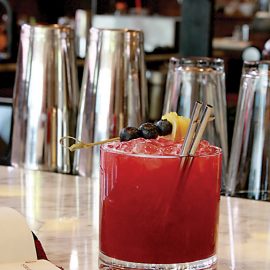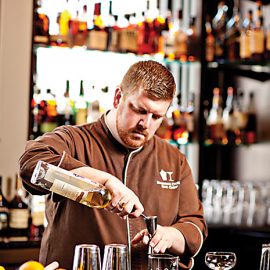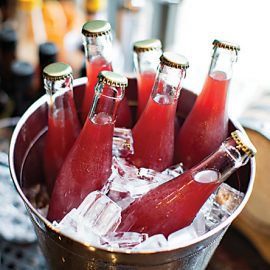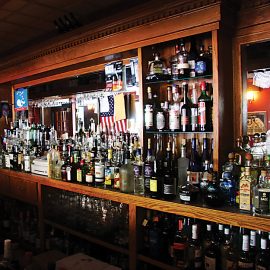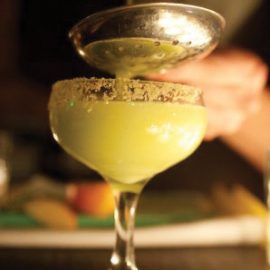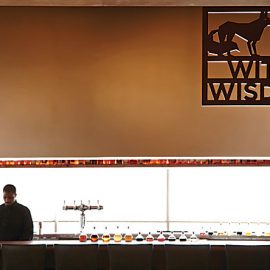Food & Drink
Cocktail Confidential
The handcrafted mixed drink is making a comeback in Baltimore.
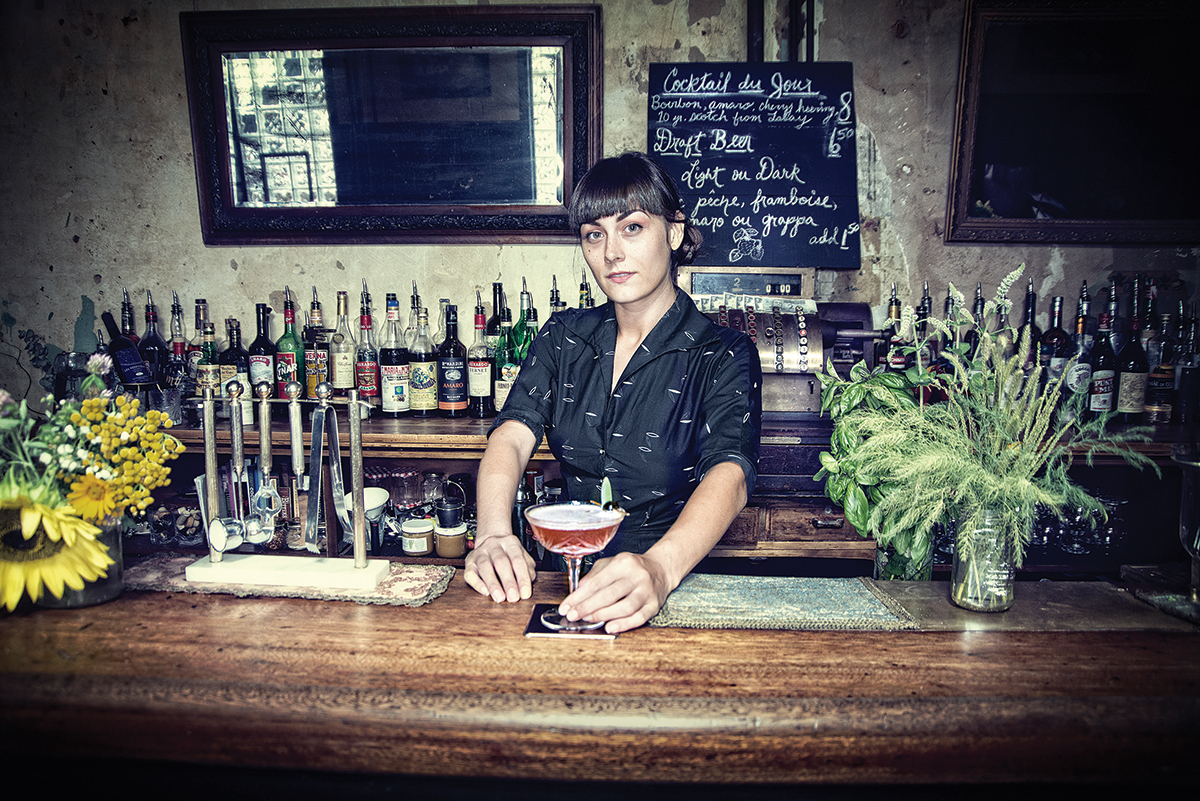
Inside the subdued walls of W.C. Harlan, a new kind of corner bar is
emerging. There are no blaring TVs in this Remington respite, just soft
jazz playing on the stereo. Patrons are chatting quietly and
thoughtfully in the vintage-inspired, candlelit space. Bartenders, clad
in retro, flowery dresses, take time to slowly craft drinks. But,
perhaps most striking are the drinks being requested: “I’ll have an old
fashioned.” “Your cocktail du jour.” “A Sazerac, please.” These orders
take a proper few minutes to make—and some are served in tiny 5.5-ounce
coupe glasses. It’s a paradox of sorts: You feel transported to a bygone
era, but this is actually the future of Baltimore bars.
Coinciding with the city’s style revolution (chronicled in the
issue), the cocktail scene is also being transformed—everywhere from
dives to restaurants to hotels. No longer does a vodka-tonic cut it, as
bartenders are crafting drinks with small-batch liquors and local
ingredients. And Baltimoreans are responding.
“People are interested in where things come from,” says Perez
Klebahn, co-owner of Mr. Rain’s Fun House. “I can say this bourbon was
produced by this family, these bitters were made in-house. In order to
be a good bartender now, your drink has to tell a story.”
That story now involves a lot of pre-Prohibition recipes, as whiskey
and gin cocktails are slowly replacing the old standby of vodka. Like
chefs, bartenders are getting their ingredients from local farmers’
markets and creating menus with innovative recipes.
In other words, Baltimore’s craft-cocktail scene is ready to
explode—and join the ranks of cities like D.C., San Francisco, New York,
and Portland. Social clubs, like the Baltimore Bartenders’ Guild, and
cocktail pop-up events are helping to drive the trend.
“It’s starting to feel like it does in other cities,” says Doug
Atwell, managing partner at Rye in Fells Point. “Nowadays, you can’t
open a bar or restaurant without a stellar craft-cocktail program.”
Of course, it wasn’t always like this. Baltimore—with its laid-back,
blue collar ethos—has long been a beer and vodka kind of town. Our idea
of a cocktail was the infamous sour-apple martini. And that reflects a
long, national history as well.
“Prohibition really killed the cocktail,” says Brendan Dorr, bar
manager at B&O American Brasserie. “Some people credit World War II
for the introduction of vodka to this country. There was this age of the
fear of flavor, and vodka, which is odorless and doesn’t really taste
like anything, really took off. For a long time, people have been
embracing the plain meat and potatoes.”
And, despite our state’s rich drinking history—rye whiskey was once
synonymous with Maryland—our bar scene fell victim to the benign
cocktail trend as well.
“When we first opened in 2009, I tried to play it safe with the
menu,” Klebahn says. “At that time, the standard drinks were
cosmopolitans or apple-tinis. Or people would just order a glass of
house wine or a dirty, shaken, vodka martini.”
When craftier cocktail bars did open up, there was a struggle to get clientele to experiment outside of their comfort zone.
“When we opened, the cocktail scene was pretty non-existent,” says
John Reusing, who opened his bar Bad Decisions five years ago. “I had to
fight people to stray from their standard orders. If they did drink a
cocktail, it was a one-and-one: a Jack and Coke or vodka tonic.”
The initial signs of craft-cocktailing begin to creep in around 2010,
as industry insiders noticed certain places beginning to experiment.
“For a while, anyone making cocktails was doing it privately in their
home. It was a hobby,” Atwell says. “But I started noticing that Mr.
Rain’s was doing well-made drinks. Woodberry [Kitchen] was for sure. But
every place we could go for a well-made drink, we had to wait for a
reservation.”
The idea of a cocktail bar sans restaurant was completely foreign to
Baltimore, but something that had been popular in other cities for a
while.
“I started seeing less vodka cocktails in bigger cities and the menus
had a lot of different whiskey and gin cocktails, a little bit of
tequila,” Dorr says. “I had started to see that cocktails weren’t just
this thing in a martini glass.”
Other bartenders took notice, too, and began experimenting with
house-made syrups, fresh ingredients, local produce, and different
spirits like pisco and mezcal. And Baltimoreans—admittedly sometimes a
bit averse to change—seemed receptive.
“I have a theory that after the recession, people started watching
out for the little guy,” says Atwell, whose bar Rye opened in 2011 as
Baltimore’s first bona-fide cocktail joint. “People started to
appreciate that we were pushing small-batch liquors. I’d rather sell
Tito’s or Buffalo Trace than Jack [Daniel’s].”
Other reasons the cocktail scene took off here include the
farm-to-table movement, the explosion of Baltimore as a restaurant
destination, and the public’s heightened interest in food, in general.
“Baltimoreans are realizing that making a cocktail is like cooking,”
says Lane Harlan, owner of W.C. Harlan (whose vintage style, not
surprisingly, landed her on our “Best-Dressed” list). “We have our
sweets, savories, sours, bittering agents, and textures. Depth is
everything.”
To create that balance of flavors, outside-of-the-box ingredients
started emerging on menus like the use of a variety of bitters, topping a
drink with an egg white for foam, and house-made infusions and syrups.
“As we’ve seen more things like creating your own bacon, making
things in-house, it seems natural that would spread to the front of the
house and bars,” says Tim Riley, beverage director at Bagby Restaurant
Group, which opened Ten Ten in 2011 and Fleet Street Kitchen in 2012.
“Now it would be tough to open a new restaurant in Baltimore without
some element of craft-cocktailing.”
Anthony Kinn, general manger at Pabu at the Four Seasons Baltimore,
is very familiar with this concept. When the hotel opened just two years
ago, the city was on the brink of the craft-cocktail movement.
“We knew that cocktails had to be a part of our concept,” says Kinn.
“We were nervous to have such an aggressive program, but we came at a
time when it was really catching on in Baltimore.”
Both Pabu and Wit & Wisdom Tavern in the Four Seasons have put
their stamps on the nightlife scene and have gradually become cocktail
destinations.
“My friends and I used to joke that we’d go to Baltimore for beer and
stay in D.C. for cocktails,” says Fritz Hahn, who has been covering
bars for The Washington Post for 10 years. “But recently, I’ve heard
people start talking about cocktails in Baltimore. A big part of that is
Rye, a big part of that is Wit & Wisdom.”
With places like W.C. Harlan, Rye, and restaurant groups and hotels
getting on board with the craft-cocktail concept, demand for small-batch
liquors has grown.
“People now want different spirits with complexity and flavor,” says
Rob Schoenfelder, division manager at Reliable Churchill, the state’s
largest liquor distributor. “Craft spirits are on the rise and domestic
beer is losing the battle.”
In fact, Schoenfelder says that sales for small-batch George Dickel
Tennessee Whiskey are up 99 percent from last year. Sales for Pimms No. 1
Cup, a retro gin cordial, are up by more than a third.
“These are brands that no one was talking about five years ago,” he
says. “Mixologists are now working with them more and more, exemplifying
the new cocktail culture.”
As the culture shifts, drinkers are becoming more educated. No longer
are they asking for martini lists, but requesting cocktail menus.
“You definitely get many more cocktail-savvy people in here,” says
Dorr about B&O. “I’ve even had people say, ‘Oh, I just bought this
new type of bitters, what should I do with it?’”
With more adventurous guests, creating cocktail menus has become a
whole lot more fun for the bartenders who have been on the scene from
the beginning. Some of the most popular cocktails now would have scared
off patrons years ago, like the gin fizz or a pisco sour.
“Before, guests used to scratch their heads when I would mention
foams, gastriques, daisies, or aperitifs,” says Klebahn at Mr. Rain’s.
“Now there is more of an understanding of what we’re trying to do. It’s
become more of a playground for us.”
A couple of years ago, as the trend started to pick up, Dorr began to
wonder how he could create a community for bartenders. At the time, he
lived next door to Corey Polyoka, former bar manager at Woodberry
Kitchen. The two began talking, naturally, over a couple of drinks.
“We started talking about where we wanted the cocktail scene to
progress in the city,” he says. “We wanted a community for bartenders
who were doing something a little craftier.”
Dorr established the Baltimore Bartenders’ Guild in 2011, a group
that discusses recipes, trends, proper technique, job openings, events,
and how to evolve Baltimore’s cocktail scene even further.
When the group started, there were only a handful of bartenders that
joined. Today, BBG has 40 paid members and meetings once a month. Dorr
has also put on seven pop-up events called the Forgotten Cocktail Club.
“There’s competition of course, but there’s a general camaraderie
among us here,” says Riley. “You’re seeing that with the Guild here in
Baltimore. People are willing to share technique and share recipes.”
Additionally, a huge part of what the BBG does is discuss the future of
Baltimore’s cocktail scene, which, most agree, is on the rise.
“As the community of bartenders grows, your going to see the whole
entire platform change,” Kinn says. “Existing restaurants will have
stronger craft concepts. Restaurant groups that are so wine-centric will
probably start to beef up their cocktail program.”
Not only that, but many in the industry agree that an entirely new genre of bar is going to surface.
“You’ll see more cocktail-only bars pop up,” Dorr says. “We already
have. First was Rye, then Harlan. The city is just waiting for that next
cocktail bar, where you can go in and either get a can of Natty Boh or a
damn good cocktail.”
